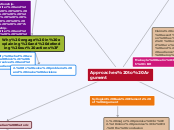Approaches to Argument
I. What is Argument?
*argument- forms of discourse that attempt to persuade readers or listeners to accept a position on a controversial issue
*referential relationship- between writer and subject *rhetorical relationship- between writer and audience *positional relationship- between subject and audience
Why engage in explaining and defending our actions?
1. to justify what we do and think, both to ourselves and to our audiences
2. to solve problems and make decisions
II. Aristotelian Rhetoric
Ethos
*describes credibility
knowledgeable/ well informed
truthful/morally upright
good intentions
Pathos
*the appeal to emotions
This is appropriate in combination with other elements of argument unless...
1.) they are irrelevant to argument and draw attention away from issues being argued
2.) they are used to conceal another purpose
Logos
*logic of an argument
example: induction
enthymeme: deduction
*deductive reasoning- drawing a conclusion based on probability
*enthymeme- a syllogism in which the conclusion is probable but not certain
*syllogism- a major premise and a minor premise lead to a logical conclusion
*inductive reasoning- drawing a conclusion based on examples
III. Rogerian Argument
Carl Rodgers' approach to communication in finding common ground
1.) brief, objective statement
2.) summarize the case for the opposition
3.) objective statement on own issue listing concerns and interests
4.) outline common ground or specify irreconcilable interests
5.) outline benefits of your solution
Audience -> Subject
IV. The Toulmin Model
*Claim- what the writer is saying about the subject
What are you trying to prove?
Claims of Fact- assert that a condition has existed, exists, or will exist and are based on fats and data that the audience will accept as being objectively verifiable
Claims of Value- attempt to prove that some things are more or less desirable that others
Claim of Policy- assert that specific policies should be instituted as a solutions to problems
*Warrant- what the audience has to believe about the subject to accept the claim
Assumption, belief, principle that is taken for granted
*Support- what the writer offers the audience to back up the claim
The materials that the arguer uses to convince an audience that his/her claim is sound
evidence
appeals to the needs and values
